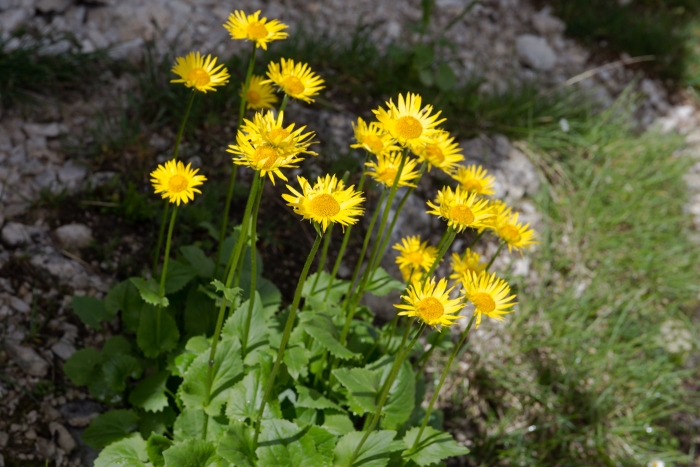Leopard’s Bane
(Doronicum columnae)
Leopard’s Bane (Doronicum columnae)
/
/

Ragnhild&Neil Crawford
CC BY-SA 2.0
Image By:
Ragnhild&Neil Crawford
Recorded By:
Copyright:
CC BY-SA 2.0
Copyright Notice:
Photo by: Ragnhild&Neil Crawford | License Type: CC BY-SA 2.0 | License URL: https://creativecommons.org/licenses/by-sa/2.0/ | Uploader: Ragnhild & Neil Crawford | Publisher: Flickr |































Estimated Native Range
Summary
Doronicum columnae, commonly known as Leopard’s Bane, is a perennial herb native to the mountainous regions Europe, where it thrives in alpine meadows, woodlands, and grassy slopes. It is often found in calcareous soils and areas with cool, moist conditions. Doronicum columnae typically grows to about 2 feet (60 cm) tall and features bright green, heart-shaped basal leaves with scalloped margins. The plant is known for its daisy-like yellow flower heads, which bloom on long, straight stems in late spring to early summer and are highly attractive to nectar-feeding insects.
Leopard’s Bane is valued for its early-season flowers, which can brighten up the garden when few other plants are in bloom. It is a popular choice for woodland gardens, borders, and cottage gardens due to its ease of maintenance and ability to naturalize in favorable conditions. While it prefers full sun to part shade, it is adaptable to various light conditions and can tolerate a range of soil types, provided they are well-drained. It is important to avoid overly dry conditions, as the plant thrives in moist soil. Leopard’s Bane can be susceptible to slug damage and may suffer from powdery mildew in hot, dry climates. It is not known to be invasive when grown outside its native range, but gardeners should monitor its spread, as it can self-seed under ideal conditions.CC BY-SA 4.0
Leopard’s Bane is valued for its early-season flowers, which can brighten up the garden when few other plants are in bloom. It is a popular choice for woodland gardens, borders, and cottage gardens due to its ease of maintenance and ability to naturalize in favorable conditions. While it prefers full sun to part shade, it is adaptable to various light conditions and can tolerate a range of soil types, provided they are well-drained. It is important to avoid overly dry conditions, as the plant thrives in moist soil. Leopard’s Bane can be susceptible to slug damage and may suffer from powdery mildew in hot, dry climates. It is not known to be invasive when grown outside its native range, but gardeners should monitor its spread, as it can self-seed under ideal conditions.CC BY-SA 4.0
Plant Description
- Plant Type: Herb
- Height: 0.5-2 feet
- Width: 1-2 feet
- Growth Rate: Moderate
- Flower Color: Yellow
- Flowering Season: Spring
- Leaf Retention: Deciduous
Growth Requirements
- Sun: Full Sun, Part Shade
- Water: Medium
- Drainage: Fast, Medium
Common Uses
Border Plant, Butterfly Garden, Deer Resistant, Low Maintenance, Rabbit Resistant, Showy Flowers
Natural Habitat
native to the mountainous regions Europe, where it thrives in alpine meadows, woodlands, and grassy slopes
Other Names
Common Names: Heart-Leaved Leopard’s Bane, Herzblättrige Gemswurz, Kale Voorjaarszonnebloem, Balkangemsrot
Scientific Names: , Doronicum orientale, Doronicum caucasicum, Doronicum columnae, Doronicum cordifolium, Doronicum pilosum, Doronicum cordatum, Doronicum columnae var. columnae, Doronicum lucidum, Doronicum romanum
GBIF Accepted Name: Doronicum columnae Ten.